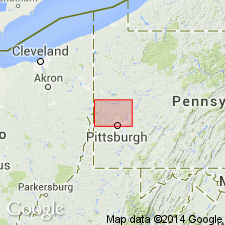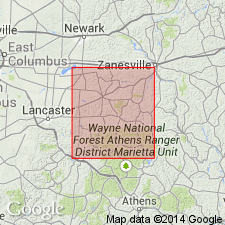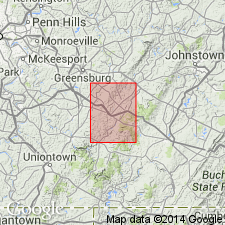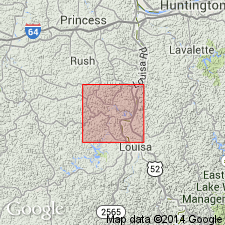
- Usage in publication:
-
- Brush Creek limestone
- Modifications:
-
- Named
- Dominant lithology:
-
- Limestone
- Shale
- AAPG geologic province:
-
- Appalachian basin
Summary:
Named Brush Creek limestone of what is called the lower barren measures series. Varies greatly in appearance, from a black calcareous shale, 4 to 5 feet thick, or compact limestone, 1 to 2 feet thick. Often has a peculiar slaty and arenaceous aspect, and sometimes contains so much iron as to be used as an ore. Usually fossiliferous. Occurs 510 ft below the Pittsburg coal. Lies 10 to 15 ft above the Brush Creek coal.
Source: GNU records (USGS DDS-6; Reston GNULEX).

- Usage in publication:
-
- Brush Creek limestone member
- Modifications:
-
- Overview
- AAPG geologic province:
-
- Appalachian basin
Summary:
Designated Brush Creek limestone member of Brush Creek cyclothem of Conemaugh series. Lithology of Brush Creek is diversified but is dominantly some kind of limestone. Different facies are: (1) gray greenish crystalline limestone, (2) dark-gray sandy micaceous limestone, 3) buff to yellowish-brown, finely crystalline limestone containing abundant patches of chert and flint, and (4) very ferruginous fossiliferous dense limestone. Everywhere bears a marine fauna. Average thickness is little more than 2 ft; ranges in thickness from 3 in. to 10 ft.
Source: GNU records (USGS DDS-6; Reston GNULEX).

- Usage in publication:
-
- Brush Creek limestone and coal
- Modifications:
-
- Overview
- AAPG geologic province:
-
- Appalachian basin
Summary:
Designated Brush Creek limestone and coal of Conemaugh Formation. The limestone is dark gray, impure, abundantly fossiliferous and has a maximum observed thickness of 14 in. The coal occurs about 10 ft below the limestone and is separated from it by carbonaceous shale. This group of beds has widespread distribution in southwestern PA. The limestone occurs about 100 ft above the Upper Freeport coal.
Source: GNU records (USGS DDS-6; Reston GNULEX).

- Usage in publication:
-
- Brush Creek Limestone Member*
- Modifications:
-
- Overview
- AAPG geologic province:
-
- Appalachian basin
Summary:
Designated Brush Creek Limestone Member of Conemaugh Formation. Consists of grayish-to yellowish-brown, finely to coarsely crystalline, fossiliferous limestone, 0.5 to 4 feet thick, generally about 1 foot thick. Locally a 2-foot-thick olive-brown fossiliferous siltstone occurs in middle. Occurs in lower part of Conemaugh Formation.
Source: GNU records (USGS DDS-6; Reston GNULEX).
For more information, please contact Nancy Stamm, Geologic Names Committee Secretary.
Asterisk (*) indicates published by U.S. Geological Survey authors.
"No current usage" (†) implies that a name has been abandoned or has fallen into disuse. Former usage and, if known, replacement name given in parentheses ( ).
Slash (/) indicates name conflicts with nomenclatural guidelines (CSN, 1933; ACSN, 1961, 1970; NACSN, 1983, 2005, 2021). May be explained within brackets ([ ]).

